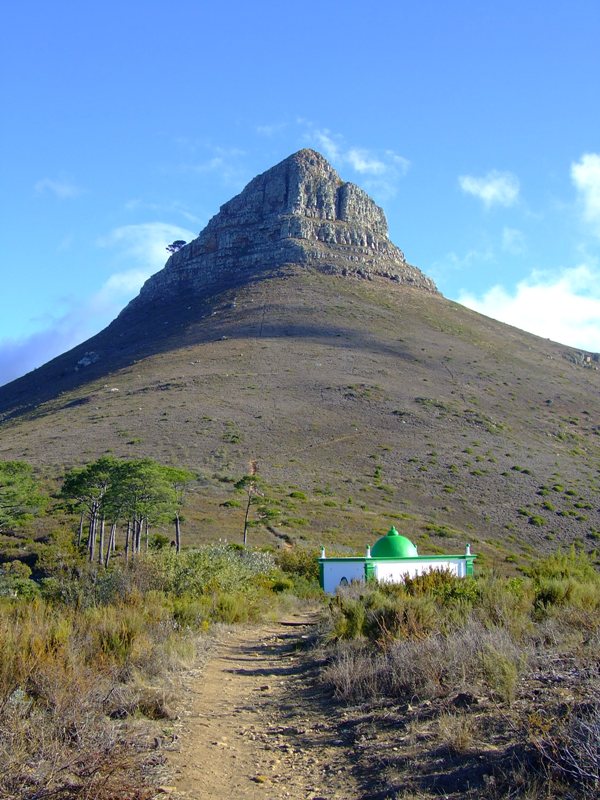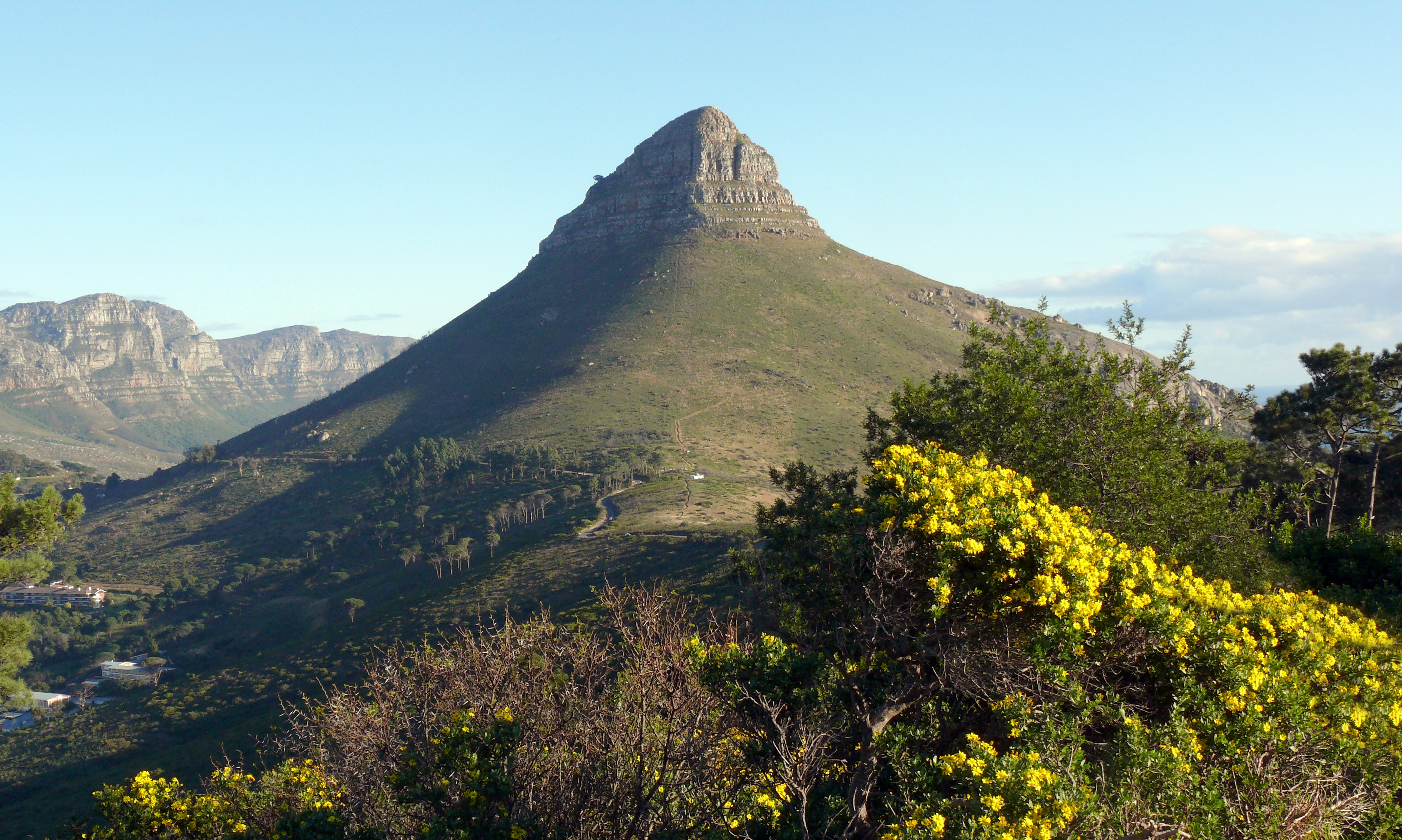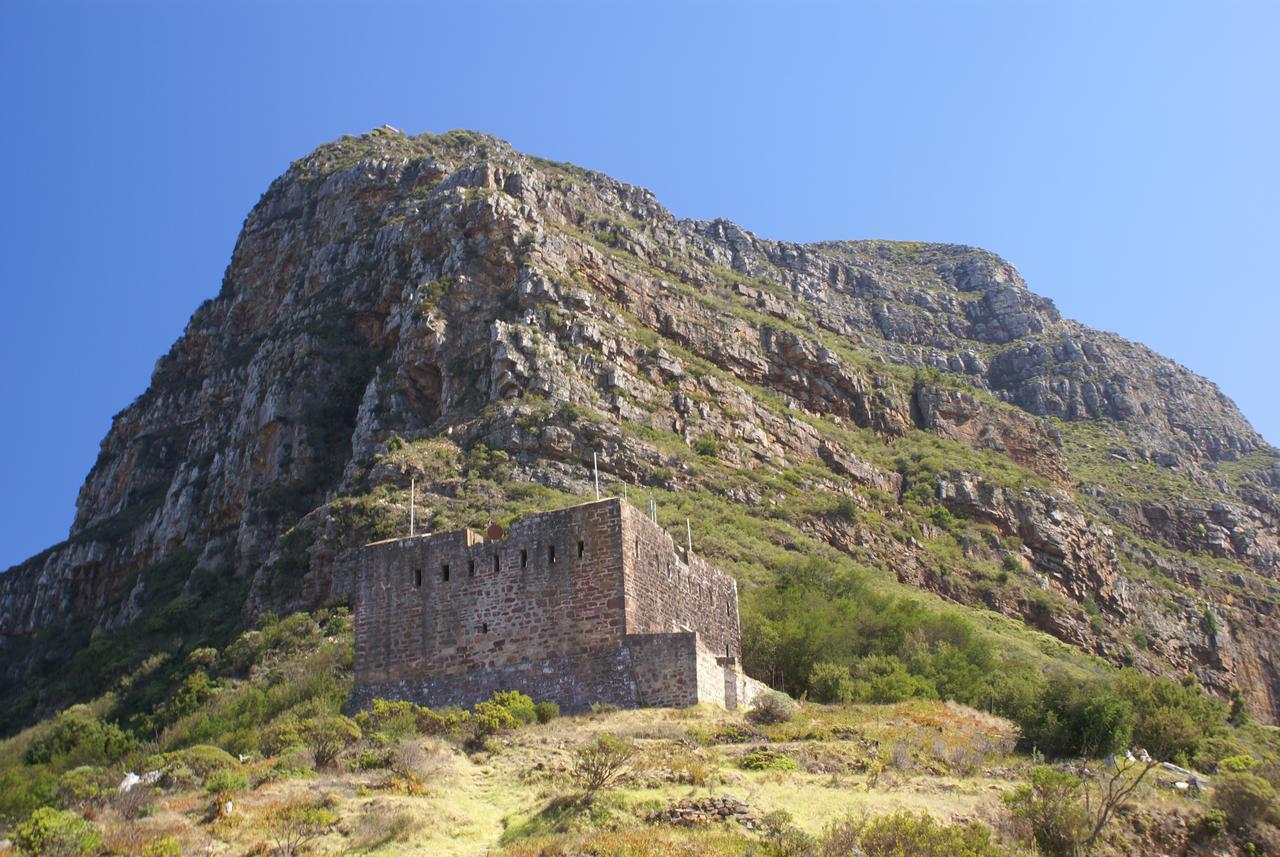|
Signal Hill (Cape Town)
Signal Hill ( af, Seinheuwel), or Lion's Rump, is a landmark flat-topped hill located in Cape Town, next to Lion's Head and Table Mountain. The hill was also known as "The Lion's Flank", a term now obsolete. Together with Lion's Head, Signal Hill looks like a lion sphinx. Signals Signal flags were used to communicate weather warnings as well as anchoring instructions to visiting ships in order to ensure that they prepared adequately for stormy weather while in the bay. Similarly, ships could use flags to signal for assistance if, for example, an anchor line parted during a storm. It is known for the Noon Gun that is operated there by the South African Navy and South African Astronomical Observatory. In 1836, a time ball was set up at the Cape Town observatory, however it was not visible to ships in the harbour, so a second time ball was erected on Signal Hill in order to relay the precise moment of 1pm Cape Mean Time. In this way ships in the bay were able to check their ... [...More Info...] [...Related Items...] OR: [Wikipedia] [Google] [Baidu] |
Lion's Head (Cape Town)
Lion's Head is a mountain in Cape Town, South Africa, between Table Mountain and Signal Hill. Lion's Head peaks at above sea level. The peak forms part of a dramatic backdrop to the city of Cape Town and is part of the Table Mountain National Park. Surrounding The suburbs of the city surround the peak and Signal Hill on almost all sides, but strict management by city authorities has kept development of housing off the higher ground. The area is significant to the Cape Malay community, who historically lived in the Bo-Kaap quarter close to Lion's Head. There are a number of historic graves and shrines ('' kramat''s) of Malay leaders on the lower slopes and on Signal Hill. History In the 17th century the peak was known as ''Leeuwen Kop'' (Lion's Head) by the Dutch, and Signal Hill was known as ''Leeuwen Staart'' (Lion's Tail), as the shape resembles a crouching lion or a sphinx. The English in the 17th Century called the peak Sugar Loaf. In 1897 gold was discovered on L ... [...More Info...] [...Related Items...] OR: [Wikipedia] [Google] [Baidu] |
Chavonnes Battery
The Chavonnes Battery was a fortification protecting Cape Town, South Africa, built in the early 18th century. It is now a museum and function venue. History The battery was one of the coastal fortifications of the Cape Peninsula linked to the Castle of Good Hope. It was built in 1714–1725 by the Dutch East India Company, and named after its originator, Maurits Pasques de Chavonnes, who was the governor of the Cape Colony. The battery was built in a “U” shape with a stone wall built on a rocky outcrop on the Western flank at the waters edge. It had 16 mounted guns with an arc of fire of nearly 180 degrees. The battery also served as a prison and a quarantine and convalescent wing of the old Somerset Hospital. It was used to protect the bay and town until 1861 when construction work started on the Alfred basin and some of the stone and rubble from the site was used to create a breakwater. Further damage occurred when coal bunkers and later a fish factory were built over ... [...More Info...] [...Related Items...] OR: [Wikipedia] [Google] [Baidu] |
Table Mountain National Park
Table Mountain National Park, previously known as the Cape Peninsula National Park, is a national park in Cape Town, South Africa, proclaimed on 29 May 1998, for the purpose of protecting the natural environment of the Table Mountain Chain, and in particular the rare fynbos vegetation. The park is managed by South African National Parks. The property is included as part of the UNESCO Cape Floral Region World Heritage Site. The park contains two well-known landmarks: Table Mountain, for which the park is named; and the Cape of Good Hope, the most southwestern extremity of Africa. History Arguments for a national park on the Cape Peninsula, centred on Table Mountain, began in earnest in the mid-1930s. The Table Mountain Preservation Board was set up in 1952, and in 1957 its recommendation to the National Monuments Board was accepted and Table Mountain was declared a national monument. In the mid 1960s, the Cape Town City Council declared nature reserves on Table Mountain, L ... [...More Info...] [...Related Items...] OR: [Wikipedia] [Google] [Baidu] |
Hills Of South Africa
A hill is a landform that extends above the surrounding terrain. It often has a distinct summit. Terminology The distinction between a hill and a mountain is unclear and largely subjective, but a hill is universally considered to be not as tall, or as steep as a mountain. Geographers historically regarded mountains as hills greater than above sea level, which formed the basis of the plot of the 1995 film ''The Englishman who Went up a Hill but Came down a Mountain''. In contrast, hillwalkers have tended to regard mountains as peaks above sea level. The ''Oxford English Dictionary'' also suggests a limit of and Whittow states "Some authorities regard eminences above as mountains, those below being referred to as hills." Today, a mountain is usually defined in the UK and Ireland as any summit at least high, while the official UK government's definition of a mountain is a summit of or higher. Some definitions include a topographical prominence requirement, typically or ... [...More Info...] [...Related Items...] OR: [Wikipedia] [Google] [Baidu] |
Devil's Peak (Cape Town)
Devil's Peak (Afrikaans: ''Duiwelspiek'') is part of the mountainous backdrop to Cape Town, South Africa. When looking at Table Mountain from the city centre, or when looking at the standard picture postcard view of the mountain, the skyline is from left to right: the spire of Devil's Peak, the flat mesa of Table Mountain, the dome of Lion's Head and Signal Hill. The central districts of Cape Town are nestled within this natural amphitheatre. The city grew out of a settlement founded on the shore below the mountains in 1652 by Jan van Riebeeck, for the Dutch East India Company. Some of the first farms in the Cape were established on the slopes of Devil's Peak, along the Liesbeek River. Devil's Peak stands high, less than Table Mountain's . One can walk to the top (western slopes provide the easiest approach) but the ascent is more pleasant and safer outside of the cold, wet, winter months of May to August. Landmarks The Rhodes Memorial to Cecil Rhodes, and the Universi ... [...More Info...] [...Related Items...] OR: [Wikipedia] [Google] [Baidu] |
Endemism
Endemism is the state of a species being found in a single defined geographic location, such as an island, state, nation, country or other defined zone; organisms that are indigenous to a place are not endemic to it if they are also found elsewhere. For example, the Cape sugarbird is found exclusively in southwestern South Africa and is therefore said to be ''endemic'' to that particular part of the world. An endemic species can be also be referred to as an ''endemism'' or in scientific literature as an ''endemite''. For example ''Cytisus aeolicus'' is an endemite of the Italian flora. ''Adzharia renschi'' was once believed to be an endemite of the Caucasus, but it was later discovered to be a non-indigenous species from South America belonging to a different genus. The extreme opposite of an endemic species is one with a cosmopolitan distribution, having a global or widespread range. A rare alternative term for a species that is endemic is "precinctive", which applies t ... [...More Info...] [...Related Items...] OR: [Wikipedia] [Google] [Baidu] |
City Bowl
The City Bowl is a part of Cape Town in South Africa. It is a natural amphitheatre-shaped area bordered by Table Bay and defined by the mountains of Signal Hill, Lion's Head, Table Mountain and Devil's Peak. The area includes the central business district of Cape Town (CBD), the harbour, the Company's Garden, and the residential suburbs of De Waterkant, Devil's Peak Estate, District Six, Zonnebloem, Gardens, Higgovale, Oranjezicht, Schotsche Kloof, Tamboerskloof, University Estate, Vredehoek, Walmer Estate and Woodstock. Central Business District Cape Town CBD in the City Bowl is a major business district in Cape Town’s metropolitan area and a financial centre of the Western Cape and South Africa. The South African parliament is located in Plein Street, and is the seat of government for six months in the year. The Western Cape provincial government and City of Cape Town The City of Cape Town ( af, Stad Kaapstad; xh, IsiXeko saseKapa) is the metropolit ... [...More Info...] [...Related Items...] OR: [Wikipedia] [Google] [Baidu] |
Peninsula Shale Renosterveld
Peninsula Shale Renosterveld (PSR) is a unique vegetation type that is found only on the slopes of Signal Hill and Devil's Peak in Cape Town, South Africa. It is critically endangered and exists nowhere else. Habitat This unique type of Renosterveld is indigenous and endemic to the Cape Town City Bowl but, due to the growth of this city, it now survives only on the slopes of Signal Hill and Devil's Peak. It is subject to very frequent fires, and is therefore dominated by a wide variety of grass and bulb species. There are a large variety of tall shrubs such as the Wax Karee, but the Renosterbos bush (the signature plant of Renosterveld) is relatively less common. At its southern boundary, this vegetation type gradually merges into Fynbos. The critically endangered blue-eyed uintjie ('' Moraea aristata'') flower is totally endemic to this vegetation type and occurs nowhere else. Soils and climate The soils in this area are composed predominantly of hard, fertile clay th ... [...More Info...] [...Related Items...] OR: [Wikipedia] [Google] [Baidu] |
Sheikh Yusuf
Abadin Tadia Tjoessoep (1626–23 May 1699), more commonly known as Sheikh Yusuf or Sheik Joseph, was an Indonesian Muslim of noble descent. He was also known as Muhammad Yusuf al-Maqassari. In 1693 he was exiled to the Cape of Good Hope, South Africa, which resulted in his establishing Islam in the Cape. Early and middle life (Nusantara) Yusuf was born as nephew of the Sultan Alauddin of Gowa, in today Makassar, Indonesia. In 1644 he embarked on the Hajj to Mecca and spent several years in Arabia learning under various pious scholars. During this period the Dutch and British East India Companies were fighting for control of the region due to its lucrative trade in spices and gold. When Yusuf left Arabia in 1664, Makassar had been captured by the Dutch, and he was unable to return home. Instead, he headed for Bantam on the island of Java, where he was welcomed by Sultan Ageng Tirtayasa. Ageng gave Yusuf the hand of one of his daughters in marriage, and made him his chief re ... [...More Info...] [...Related Items...] OR: [Wikipedia] [Google] [Baidu] |
Sheikh
Sheikh (pronounced or ; ar, شيخ ' , mostly pronounced , plural ' )—also transliterated sheekh, sheyikh, shaykh, shayk, shekh, shaik and Shaikh, shak—is an honorific title in the Arabic language. It commonly designates a chief of a tribe or a royal family member in Arabian countries, in some countries it is also given to those of great knowledge in religious affairs as a surname by a prestige religious leader from a chain of Sufi scholars. It is also commonly used to refer to a Muslim religious scholar. It is also used as an honorary title by people claiming to be descended from Hasan ibn Ali and Husayn ibn Ali both patrilineal and matrilineal who are grandsons of the Islamic prophet Muhammad. The term is literally translated to "Elder" (is also translated to " Lord/ Master" in a monarchical context). The word 'sheikh' is mentioned in the 23rd verse of Surah Al-Qasas in the Quran. Etymology and meaning The word in Arabic stems from a triliteral root connected ... [...More Info...] [...Related Items...] OR: [Wikipedia] [Google] [Baidu] |
Mazar (mausoleum)
A ''mazār'' ( ar, مزار), or ''darīh'' () in the Maghreb, is a mausoleum or shrine in some places of the world, typically that of a saint or notable religious leader. Medieval Arabic texts may also use the words ''mašhad'' or ''maqām'' to denote the same concept. Etymology *''Mazār'', plural ''mazārāt'' (), is related to the word '' ziyāra'' (, meaning "visitation"). It refers to a place and time of visiting. Arabic in origin, the word has been borrowed by Persian and Urdu. *''Darīh'', plural ''adriha'' () or ''dara'ih'' (), is related to the verb ''daraha'' ( meaning "to inter"). It is commonly used in the Maghreb. Specific types of shrines *''Mashhad'' (), plural ''mashāhid'', usually refers to a structure holding the tomb of a holy figure, or a place where a religious visitation occurred. Related words are ''shāhid'' (‘witness’) and ''shahīd'' (‘martyr’). A mashhad often had a dome over the place of the burial within the building. Some had a minaret. ... [...More Info...] [...Related Items...] OR: [Wikipedia] [Google] [Baidu] |






.jpg)



